Resident Crews of the International Space Station (ISS)
![]()
ISS: Expedition 64 |
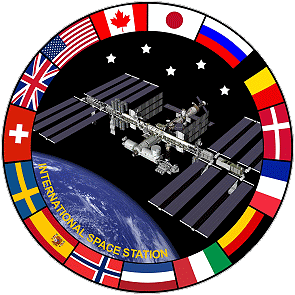 |
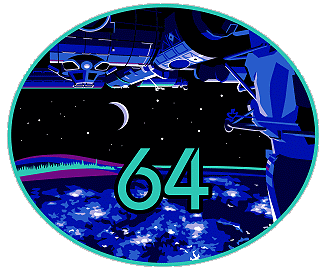 |
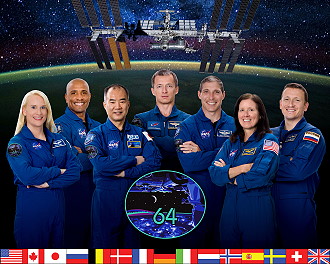 |
crew poster |
|
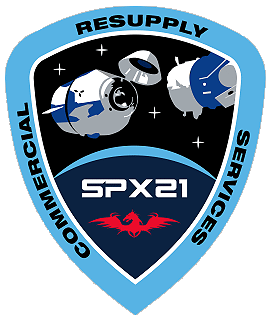 |
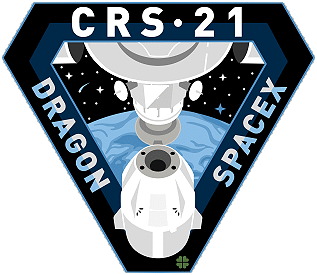 |
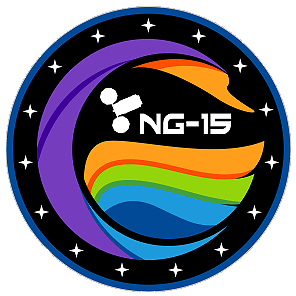 |
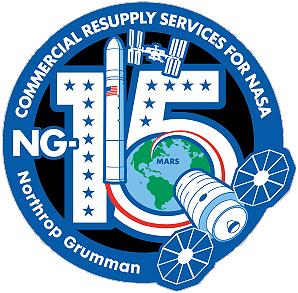 |
![]()
Crew, launch- and landing data
| No. | Nation | Surname | Given names | Position | Spacecraft (launch) |
Launch date |
Launch time |
Spacecraft (landing) |
Landing date |
Landing time |
Mission duration |
Orbits |
| 1 | Ryzhikov | Sergei Nikolaevich | ISS-CDR | Soyuz MS-17 | 14.10.2020 | 05:45:04.536 UTC | Soyuz MS-17 | 17.04.2021 | 04:55:07.9 UTC | 184d 23h 10m 03s | 2960 | |
| 2 | Kud-Sverchkov | Sergei Vladimirovich | Flight Engineer-5 | Soyuz MS-17 | 14.10.2020 | 05:45:04.536 UTC | Soyuz MS-17 | 17.04.2021 | 04:55:07.9 UTC | 184d 23h 10m 03s | 2960 | |
| 3 | Rubins | Kathleen Hallisey "Kate" | Flight Engineer-3 | Soyuz MS-17 | 14.10.2020 | 05:45:04.536 UTC | Soyuz MS-17 | 17.04.2021 | 04:55:07.9 UTC | 184d 23h 10m 03s | 2960 | |
| 4 | Hopkins | Michael Scott | Flight Engineer-10 | SpaceX Crew-1 | 16.11.2020 | 00:27:17.483 UTC | SpaceX Crew-1 | 02.05.2021 | 06:56:43 UTC | 167d 06h 29m 26s | 2688 | |
| 5 | Glover | Victor Jerome | Flight Engineer-11 | SpaceX Crew-1 | 16.11.2020 | 00:27:17.483 UTC | SpaceX Crew-1 | 02.05.2021 | 06:56:43 UTC | 167d 06h 29m 26s | 2688 | |
| 6 | Noguchi | Soichi | Flight Engineer-12 | SpaceX Crew-1 | 16.11.2020 | 00:27:17.483 UTC | SpaceX Crew-1 | 02.05.2021 | 06:56:43 UTC | 167d 06h 29m 26s | 2688 | |
| 7 | Walker | Shannon | Flight Engineer-13 | SpaceX Crew-1 | 16.11.2020 | 00:27:17.483 UTC | SpaceX Crew-1 | 02.05.2021 | 06:56:43 UTC | 167d 06h 29m 26s | 2688 | |
| 8 | Novitsky | Oleg Viktorovich | Flight Engineer-4 | Soyuz MS-18 | 09.04.2021 | 07:42:40.496 UTC | Soyuz MS-18 | 17.10.2021 | 04:35:30.3 UTC | 190d 20h 52m 50s | 3056 | |
| 9 | Dubrov | Pyotr Valerievich | Flight Engineer-5 | Soyuz MS-18 | 09.04.2021 | 07:42:40.496 UTC | Soyuz MS-19 | 30.03.2022 | 11:28:01.2 UTC | 355d 03h 45m 21s | 5680 | |
| 10 | Vande Hei | Mark Thomas | Flight Engineer-6 | Soyuz MS-18 | 09.04.2021 | 07:42:40.496 UTC | Soyuz MS-19 | 30.03.2022 | 11:28:01.2 UTC | 355d 03h 45m 21s | 5680 |
unofficial Backup Crew
| No. | Nation | Surname | Given names | Position |
| 1 | Novitsky | Oleg Viktorovich | ISS-CDR | |
| 2 | Dubrov | Pyotr Valerievich | Flight Engineer | |
| 3 | Vande Hei | Mark Thomas | Flight Engineer | |
| 4 / 5 | Lindgren | Kjell Norwood | Flight Engineer | |
| 6 | Hoshide (?) | Akihiko | Flight Engineer | |
| 7 | ||||
| 8 | Shkaplerov | Anton Nikolayevich | Flight Engineer | |
| 9 | Artemyev | Oleg Germanovich | Flight Engineer | |
| 10 | McClain | Anne Charlotte "Annimal" | Flight Engineer |
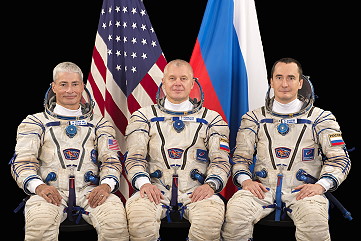 |
 |
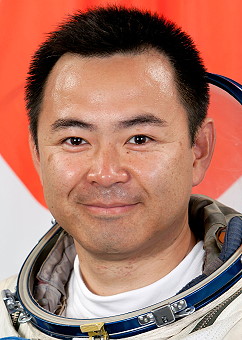 |
 |
Expedition Report
|
ISS Expedition 64 began with the undocking of Russian
spacecraft Soyuz
MS-16 on October 21, 2020 at 23:32:09
UTC. The landing crew consisted of Anatoli
Ivanishin, Ivan
Vagner and Christopher
Cassidy. Three-and-a-half-hours later the crew landed safely
in Kazakhstan. So, the new Expedition 64 consisted of
ISS Commander Sergei
Ryzhikov, Sergei
Kud-Sverchkov and Kathleen
Rubins. On November 12, 2020 an ISS reboost was performed using Progress MS-14 thrusters. This reboost was to set up for the launch of manned spacecraft Soyuz MS-18 in spring 2021. The engines started at 19:50 UTC and fired 363.5 seconds. After the corrective maneuver, the average orbit of the ISS increased by 1,100 meters. The actual parameters are 418.42 km x 437.95 km. The ISS needs 92.90 minutes for each orbit. The SpaceX Crew-1 mission launched on November 16, 2020 from Launch Complex 39A at NASA's Kennedy Space Center in Florida. This was the first crew rotation flight of the SpaceX Crew Dragon spacecraft on a Falcon 9 rocket following certification by NASA for regular flights to the space station as part of the agency's Commercial Crew Program. The SpaceX Crew-1 flight carried Crew Dragon Commander Michael Hopkins, Pilot Victor Glover, and Mission Specialist Shannon Walker along with Japan Aerospace Exploration Agency (JAXA) Mission Specialist Soichi Noguchi to the space station for a six-month science mission. Following a 15-hours solo flight SpaceX Crew-1 docked to the International Space Station on November 17, 2020. The first spacewalk in Expedition 64 was performed by Sergei Ryzhikov and Sergei Kud-Sverchkov on November 18, 2020 (6h 48m). They exited the space station through the Poisk module on the space-facing side of the station's Russian segment. The hatch was opened at 15:12 UTC a first time for leak tightness check for the exit hatch in Poisk and closed again at 15:20 UTC. The tasks after re-opening at 15:55 UTC were, replacement of the liquid flow regulator's removable panel on Zarya (aborted because of a "bulky bolt"), work on scientific equipment, commutation of the Tranzit-B antenna on Pirs to the Poisk module (to ensure continuity of communications with the Orlan suits) change the position of sensors for the precipitation and pressure control unit on the Poisk module. The Earth-facing Pirs will be replaced by the new Russian Multipurpose Laboratory Module, named "Nauka", Russian for "science", which is being prepared for launch at the Baikonur Cosmodrome in Kazakhstan. NASA commercial cargo provider SpaceX launched its 21st commercial resupply services mission to the International Space Station at 16:17:08 UTC on December 06, 2020. Loaded with 6,400 pounds (2,900 kilograms) supplies and critical materials to directly support dozens of the more than 250 science and research investigations that will occur during Expeditions 64 and beyond, the upgraded SpaceX Dragon spacecraft (CRS-21 or SpX-21) launched on a Falcon 9 rocket from Space Launch Complex 40 at Cape Canaveral Air Force Station (CCAFS) in Florida. This mission was the first cargo resupply mission on the company's upgraded version of its Dragon spacecraft. The Nanoracks Bishop Airlock is packed in the Dragon spacecraft's trunk for its ride to the orbiting laboratory. The first commercially funded space station airlock - an airtight segment used for transfer of payloads between the inside and outside of the station - will provide payload hosting, robotics testing, and satellite deployment while also serving as an outside toolbox for astronauts conducting spacewalks. Among the investigations riding inside the Dragon's pressurized capsule is a variety of research, including studies on the effects of microgravity on cardiovascular cells and how space conditions affect the interaction between microbes and minerals, as well as a technology demonstration of a blood analysis tool in space. This was the 21st SpaceX mission to deliver science investigations, supplies, and equipment for NASA and the first under the agency's second Commercial Resupply Services (CRS-2) contract. Cargo resupply from U.S. companies ensures a national capability to deliver critical science research to the space station, significantly increasing NASA's ability to conduct new investigations at the only laboratory in space. With this first flight under the CRS-2 contract, SpaceX and NASA will build upon the success of the missions flown under the first commercial resupply contract. SpaceX has completed 20 Dragon missions to and from the space station, providing more than 95,000 pounds (43,000 kilograms) of supplies and 75,000 pounds (34,000 kilograms) of return mass. About 12 minutes after launch, Dragon separated from the Falcon 9 rocket's second stage and began a carefully choreographed series of thruster firings to reach the space station. Arrival to the space station was on December 07, 2020. Dragon autonomously docked at 18:40 UTC to the station's Harmony module with Expedition 64 Flight Engineers Kathleen Rubins and Victor Glover monitoring operations. Robotics controllers on Earth installed on December 19, 2020 by using the Canadarm2 robotic arm the new NanoRacks Bishop science airlock delivered December 07, 2020 aboard the SpaceX Cargo Dragon resupply ship. During a series of hours-long maneuvers, Bishop was extracted from Dragon's unpressurized trunk and installed on the port side of the Tranquility module adjacent to BEAM, the Bigelow Expandable Activity Module. Bishop significantly increases the capacity for public and private research on the outside of the orbiting lab. The new science airlock also enables the deployment of larger satellites and the transfer of spacewalking tools and hardware inside and outside the station. Richard Garriott, an entrepreneur and one of the first touristic astronauts, sayed he smuggled James Doohan's ashes onto the ISS in 2008 during a 12-day mission as a private astronaut in a plot concocted by Chris Doohan. The late James Doohan, who famously portrayed chief engineer Montgomery "Scotty" Scott on the original TV series "Star Trek," had his ashes smuggled aboard the International Space Station, where they fittingly float in space today. His ashes were under the cladding on the floor of the space station's Columbus module, where he hid it in 2008. "I have been keeping a secret for over 12 years," Chris Doohan, one of the sons of the "Star Trek" actor wrote on Twitter, adding a link to a December 25, 2020 article from the Times of London that revealed the secret. The Starship Enterprise engineer has travelled nearly 1.7 billion miles through space, orbiting Earth more than 70,000 times, after his ashes were hidden secretly on the ISS. Northrop Grumman's uncrewed Cygnus spacecraft NG-14 departed the International Space Station on January 06, 2021, more than three months after delivering nearly 8,000 pounds (3,630 kilograms) of supplies, scientific investigations, commercial products, hardware, and other cargo to the orbiting outpost. Flight controllers on the ground sent commands to robotically detach Cygnus from the Unity module's Earth-facing port, maneuver it into place, and released it from the Canadarm2 robotic arm. Kathleen Rubins monitored Cygnus' systems upon its departure from the space station. Prior to departure, the crew packed Cygnus with the Saffire V investigation (a fire experiment), the SharkSat hosted payload, and several thousand pounds of trash. After departure, Cygnus will conduct an extended mission in orbit, hosting experiments, before performing a safe re-entry and burning up in Earth's atmosphere. The Cygnus resupply spacecraft is named in memory of Kalpana Chawla, the first female astronaut of Indian descent. Chawla, who dedicated her life to understanding flight dynamics, died in the STS-107 space shuttle Columbia accident. Cygnus arrived at the space station October 05, 2020 following an October 02, 2020 launch on Northrop Grumman's Antares rocket from NASA's Wallops Flight Facility on Wallops Island, Virginia. The SpaceX Dragon that arrived to the International Space Station on the company's 21st resupply services mission for NASA departed on January 12, 2021 loaded with 5,200 pounds (2,400 kilograms) of scientific experiments and other cargo. The upgraded Dragon spacecraft executed the first undocking of a U.S. commercial cargo craft from the International Docking Adapter at 14:05 UTC, with NASA astronaut Victor Glover monitoring aboard the station. Dragon fired its thrusters to move a safe distance from the station's space-facing port of the Harmony module, then initiated a deorbit burn to begin its re-entry sequence into Earth's atmosphere. Dragon is expected to make its parachute-assisted splashdown around 01:27 UTC, January 14, 2021. - the first return of a cargo resupply spacecraft in the Atlantic Ocean. Splashing down off the coast of Florida enables quick transportation of the science aboard the capsule to the agency's Kennedy Space Center's Space Station Processing Facility, and back into the hands of the researchers. This shorter transportation timeframe allows researchers to collect data with minimal loss of microgravity effects. For splashdowns in the Pacific Ocean, quick-return science cargo is processed at SpaceX's facility in McGregor, Texas, and delivered to NASA's Johnson Space Center in Houston. Dragon launched December 06, 2020 on a SpaceX Falcon 9 rocket from Launch Complex 39A at NASA's Kennedy Space Center in Florida, arriving at the station just over 24 hours later and achieving the first autonomous docking of a U.S. commercial cargo resupply spacecraft. Previous arriving cargo Dragon spacecraft were captured and attached to the space station by astronauts operating the station's robotic Canadarm2. The spacecraft delivered more than 6,400 pounds (2,900 kilograms) of hardware, research investigations and crew supplies. The upgraded cargo Dragon capsule used for this mission contains double the powered locker availability of previous capsules, allowing for a significant increase in the research that can be carried back to Earth. Some of the scientific investigations Dragon will return to Earth include: Cardinal Heart: Microgravity causes changes in the workload and shape of the human heart, and it is still unknown whether these changes could become permanent if a person lived more than a year in space. Cardinal Heart studies how changes in gravity affect cardiovascular cells at the cellular and tissue level using 3D-engineered heart tissues, a type of tissue chip. Results could provide new understanding of heart problems on Earth, help identify new treatments, and support development of screening measures to predict cardiovascular risk prior to spaceflight. Space Organogenesis: This investigation from JAXA (Japan Aerospace Exploration Agency) demonstrates the growth of 3D organ buds from human stem cells to analyze changes in gene expression. Cell cultures on Earth need supportive materials or forces to achieve 3D growth, but in microgravity, cell cultures can expand into three dimensions without those devices. Results from this investigation could demonstrate advantages of using microgravity for cutting-edge developments in regenerative medicine and may contribute to the establishment of technologies needed to create artificial organs. Sextant Navigation: The sextant used in the Sextant Navigation experiment will be returning to Earth. Sextants have a small telescope-like optical sight to take precise angle measurements between pairs of stars from land or sea, enabling navigation without computer assistance. Sailors have navigated via sextants for centuries, and NASA's Gemini missions conducted the first sextant sightings from a spacecraft. This investigation tested specific techniques for using a sextant for emergency navigation on spacecraft such as NASA's Orion, which will carry humans on deep-space missions. Rodent Research-23: This experiment studies the function of arteries, veins, and lymphatic structures in the eye and changes in the retina of mice before and after spaceflight. The aim is to clarify whether these changes impair visual function. At least 40 percent of astronaut's experience vision impairment known as Spaceflight-Associated Neuro-ocular Syndrome (SANS) on long-duration spaceflights, which could adversely affect mission success. Thermal Amine Scrubber: This technology demonstration tested a method to remove carbon dioxide (CO2) from air aboard the International Space Station, using actively heated and cooled amine beds. Controlling CO2 levels on the station reduces the likelihood of crew members experiencing symptoms of CO2 buildup, which include fatigue, headache, breathing difficulties, strained eyes, and itchy skin. Bacterial Adhesion and Corrosion: Bacteria and other microorganisms have been shown to grow as biofilm communities in microgravity. This experiment identifies the bacterial genes used during biofilm growth, examines whether these biofilms can corrode stainless steel, and evaluates the effectiveness of a silver-based disinfectant. This investigation could provide insight into better ways to control and remove resistant biofilms, contributing to the success of future long-duration spaceflights. On January 21, 2021 an ISS reboost was performed using Progress MS-14 thrusters. This reboost was to set up for the launch of manned spacecraft Soyuz MS-18 in spring 2021. The engines started at 16:14 UTC and fired 417.5 seconds. After the corrective maneuver, the average orbit of the ISS increased by 1,200 meters. The actual parameters are 420.09 km x 436.17 km. The ISS needs 92.91 minutes for each orbit. The second spacewalk in Expedition 64 performed Michael Hopkins and Victor Glover on January 27, 2021 (6h 56m). This spacewalk focused on completing cable and antenna rigging for the "Bartolomeo" science payloads platform outside the ESA (European Space Agency) Columbus module. The duo also configured a Ka-band terminal, known as COL-Ka, that will enable an independent, high-bandwidth communication link to European ground stations. Bartolomeo is partially operational and in a safe configuration following the connection of four of six cables to the science platform, and the final two cables that could not be connected will be attended to on a future spacewalk. After completing the upgrades on the Columbus module, Michael Hopkins and Victor Glover removed a grapple fixture bracket on the far port (left) truss in preparation for future power system upgrades. Victor Glover also worked to replace a suspected broken pin inside the station's airlock as a "get ahead" task, but teams determined that a replacement pin was not needed after an inspection confirmed the current pin to be functioning properly. For another EVA on February 01, 2021 (5h 20m) Michael Hopkins and Victor Glover left again the International Space Station. This spacewalk addressed a variety of tasks, including installation of a final lithium-ion battery adapter plate on the port 4 (P4) truss that wrapped up battery replacement work begun in January 2017. Michael Hopkins and Victor Glover replaced an external camera on the starboard truss, installed a new high-definition camera on the Destiny laboratory, and replaced components for the Japanese robotic arm's camera system outside the Kibo module. Filled with trash, the unpiloted Russian cargo ship Progress MS-15 undocked from the Pirs module of the International Space Station at 05:21:30 UTC on February 09, 2021. Later Russian flight controllers sent commands to fire the Progress' engines and deorbit the space freighter, sending it to a destructive entry over the unpopulated South Pacific Ocean. The launch of the unpiloted Russian Progress MS-16 occurred on February 15, 2021 at 04:45:05.310 UTC from the Baikonur Cosmodrome in Kazakhstan. The freighter delivers almost two-and-half tons material. It transports 600 kg of tank fuel, 420 liters of drinking water for the Rodnik system and 40.5 kg of compressed gases with its own nitrogen reserves as well as around 1,400 kg, space experimentation, medical inspection and hygiene and hygiene items, clothing, standard food rations and good food for the crew members of this expedition. In addition, there is a repair and restoration kit in the trunk, which consists of a set of reinforcement linings with an adhesive bond, which are intended to temporarily seal the detected defects in the housing of the transition chamber of the Zvezda service module. The Progress MS-16 spacecraft docked to the Pirs module at the Russian segment on February 17, 2021 at 06:26:47 UTC. It was manually docked by Sergei Ryzhikov. Progress MS-16 will remain docked at the station for more than six months before departing in July 2021 for its deorbit into Earth's atmosphere. Northrop Grumman launched its 15th resupply mission to the International Space Station on February 20, 2021 at 17:36:54.3 UTC from NASA's Wallops Flight Facility on Wallops Island. Loaded with approximately 8,000 pounds (3,630 kilograms) of research, crew supplies, and hardware, Northrop Grumman's Cygnus NG-15 cargo spacecraft launched on the company's Antares rocket. The Cygnus spacecrafts dubbed the SS Katherine Johnson. Highlights of space station research facilitated by this Cygnus mission are: Spaceborne Computer-2, a high-performance commercial off-the-shelf computer system being studied to increase data processing speeds for science aboard the space station LambdaVision's, second experiment headed to the space station to study the advantages of manufacturing artificial retinas in space Micro-16, an investigation studying muscle strength changes in worms to help us better understand muscle weakening that astronauts can experience in microgravity The Real-Time Protein Crystal Growth-2 experiment, which will demonstrate new methods for producing high-quality protein crystals in microgravity A-HoSS, a radiation detection system developed for the Orion spacecraft and certified for use on NASA's Artemis II mission, the first mission on which a crew of astronauts will orbit the Moon in the spacecraft Exploration ECLSS: Brine Processor System, a demonstration in regenerative life support technology that will help provide more clean air and water to the space station crew. Cygnus arrived at the space station on February 22, 2021. Soichi Noguchi captured Cygnus at 09:38 UTC, with Michael Hopkins acting as a backup. After Cygnus capture, mission control in Houston sent ground commands for the station's arm to rotate and install it on the station's Unity module Earth-facing port (12:16 UTC). On February 28, 2021 Kathleen Rubins and Victor Glover stepped out of the space station for another EVA to begin assembling and installing modification kits required for upcoming solar array upgrades (7h 04m). The current solar arrays are functioning well, but have begun to show signs of degradation, as expected, as they were designed for a 15-year service life. The first pair of solar arrays were deployed in December 2000 and have been powering the station for more than 20 years. Later this year, the new solar arrays will be positioned in front of six of the current arrays, increasing the station's total available power from 160 kilowatts to up to 215 kilowatts. The duo worked near the farthest set of existing solar arrays on the station's left (port) side, known as P6. Victor Glover built a bracket structure and worked with Kathleen Rubins to attach the bracket and support struts to the mast canister, the base, of one of the P6 solar arrays, known as 2B. One of the bolts did not fully engage on the first attempt, so Kathleen Rubins used a power drill to back it out and reseat it, then used a ratchet wrench to tighten the bolt, reaching a safe configuration. The bolt likely will need to be secured further before installing one of the new solar arrays that will be delivered to the space station later this year aboard SpaceX's 22nd commercial resupply services mission. Kathleen Rubins and Victor Glover then moved to begin identical assembly work for the bracket for the second of the P6 solar array pair, known as 4B. They completed the construction of upper support hardware and secured it to the space station's exterior structure until work can be completed on the next spacewalk on March 05, 2021. Kathleen Rubins and Soichi Noguchi ventured outside the orbiting outpost on March 05, 2021 (6h 56m) to complete several tasks. They completing the modification kits for the IROSA solar arrays to be delivered to ISS later this year. The duo worked near the farthest set of existing solar arrays on the station's left (port) side, known as P6, to install a modification kit on solar array 4B and reconfigure the modification kit on 2B, completing tasks that were started during the February 28 , 2021 spacewalk. Due to time constraints, the secondary tasks of troubleshooting the Columbus Parking Position (PAPOS) Interface and removing and replacing a Wireless Video System External Transceivers Assembly (WETA) were deferred to a later spacewalk. The astronauts did, however, complete an additional task of relocating an Articulating Portable Foot Restraint (APFR). NASA is augmenting six of the eight existing power channels of the space station with new solar arrays, which will be delivered on SpaceX's 22nd commercial resupply services mission. The new solar arrays, a larger version of the Roll-Out Solar Array (ROSA) technology, will be positioned in front of six of the current arrays, ultimately increasing the station's total available power from 160 kilowatts to up to 215 kilowatts and ensuring sufficient power supply for NASA's exploration technology demonstrations for Artemis and beyond. The current solar arrays are functioning well but have begun to show signs of degradation, as expected, as they were designed for a 15-year service life. On March 12, 2021 an ISS reboost was performed using Progress MS-14 thrusters. This reboost was to set up for the launch of manned spacecraft Soyuz MS-18 on April 09, 2021. The engines started at 19:09 UTC and fired 114.2 seconds. After the corrective maneuver, the average orbit of the ISS increased by 450 meters. The actual parameters are 418.82 km x 439.69 km. The ISS needs 92.90 minutes for each orbit. Victor Glover and Michael Hopkins ventured outside the Quest airlock on March 13, 2021 (6h 47m) to complete a variety of tasks that could not be completed on a series of previous excursions. They vent and relocated ammonia jumper cables and relocated one of them near the Quest airlock in order to reconnect the jumper cable to the current cooling system, increasing its efficiency. The duo installed a structural "stiffener" on the airlock thermal cover, and completed the connection of payload cables on the new Bartolomeo platform on the Columbus module. Other tasks included the replacement of a wireless communications antenna on the Unity module. The duo began their work on the station's port truss, or "backbone," completing tasks that were deferred from previous spacewalks. The spacewalkers successfully vented the early ammonia system (EAS), relocated one of its jumper lines, and serviced the Columbus Bartolomeo payload platform, including routing three of four cables on the Payload Position (PAPOS) interface (Columbus Parking Position) and configuring a cable for an amateur radio system. The astronauts deferred the task of installing clamps on Bartolomeo in order to route cables for high-definition cameras. The pair also replaced a wireless antenna assembly (WETA) on the Unity module and installed hardware to provide additional structural integrity on the airlock. Three residents of the International Space Station took a spin around their orbital neighborhood in the Soyuz MS-17 on March 19, 2021 relocating the spacecraft to prepare for the arrival of the next set of crew members. Commander Sergei Ryzhikov, Sergei Kud-Sverchkov and Kathleen Rubins undocked from the Earth-facing port of the station's Rassvet module at 16:38:27 UTC and docked again at the space-facing Poisk docking port at 17:12:35 UTC. The relocation will free up the Rassvet port for the docking of another Soyuz vehicle, designated Soyuz MS-18, which will carry three Expedition 65 crew members to the station in April 2021. On April 02, 2021 an ISS reboost was performed using Progress MS-14 thrusters. This reboost was to set up for the launch of manned spacecraft Soyuz MS-18 on April 09, 2021. The engines started at 12:14 UTC and fired 129.3 seconds. After the corrective maneuver, the average orbit of the ISS increased by 360 meters. The actual parameters are 418.17 km x 439.77 km. The ISS needs 92.91 minutes for each orbit. The SpaceX Crew-1 astronauts aboard the International Space Station marked another first for commercial spaceflight on April 05, 2021 when the four astronauts relocated the Crew Dragon spacecraft to prepare for the arrival of new crew members in late April and the upcoming delivery of new solar arrays this summer. Michael Hopkins, Victor Glover, Shannon Walker and Soichi Noguchi, undocked Crew Dragon Resilience from the forward port of the station's Harmony module at 10:30 UTC and docked to the space-facing port at 11:08 UTC. The relocation made the Harmony's forward port free for the docking of Crew Dragon Endeavour, set to carry four crew members to the station on NASA's SpaceX Crew-2 mission. Shane Kimbrough, Megan McArthur, Akihiko Hoshide and Thomas Pesquet are scheduled to launch to the station April 22, 2021 from Launch Complex 39A at NASA's Kennedy Space Center in Florida. Following an only three-hours solo flight Soyuz MS-18 docked to ISS on April 09, 2021. Oleg Novitsky, Pyotr Dubrov and Mark Vande Hei became the ISS Expedition 64 (together with ISS Expedition 63 crew members Sergei Ryzhikov, Sergei Kud-Sverchkov and Kathleen Rubins along with SpaceX Crew-1 astronauts Michael Hopkins, Victor Glover, Soichi Noguchi and Shannon Walker). With the arrival of Soyuz MS-18 Expedition 64 became a ten-person-crew. Finally, the station command changed from Russian cosmonaut Sergei Ryzhikov to US astronaut Shannon Walker. ISS Expedition 64 concluded with the undocking of Russian spacecraft Soyuz MS-17 on April 17, 2021 at 01:34:04 UTC. The landing crew consisted of Sergei Ryzhikov, Sergei Kud-Sverchkov and Kathleen Rubins. Three-and-a-half-hours later the crew landed safely in Kazakhstan. So, the new Expedition 65 consisted of ISS Commander Shannon Walker, Michael Hopkins, Victor Glover, Soichi Noguchi, Oleg Novitsky, Pyotr Dubrov and Mark Vande Hei. Among the US experiments are: Plant Habitat-02: A new crop is heading to the International Space Station: radishes! When astronauts travel to the Moon and Mars, they are likely to grow edible plants to supplement food brought from Earth. To produce nutritious food in space, we need to understand how the differences in gravity, atmosphere, and soil conditions affect the way plants grow. As part of ongoing efforts to produce food in space, the Plant Habitat-02 investigation uses the Advanced Plant Habitat aboard the space station to grow radishes in different types of light and soils. Radishes are nutritious, grow quickly, and are genetically similar to Arabidopsis, a plant that scientists have already studied a lot in microgravity. This research also evaluates the nutrition and taste of the plants, because even space explorers like their food to taste good. Onco-Selectors: Scientists use many screening methods and models in efforts to develop cancer drugs that work better and have fewer harmful side effects. Leveraging Microgravity to Screen Onco-selective Messenger RNAs for Cancer Immunotherapy (Onco-Selectors) tests drugs based on messenger ribonucleic acids (mRNA) for treating leukemia. Found in all our cells, mRNA plays a role in the process of making proteins and it can be different in healthy versus cancer cells. Under normal gravity conditions, some drugs are onco-selective, or can tell cancer cells from healthy ones. Researchers expect the ones that also have this trait in microgravity will make good candidates for safer, more effective, and affordable medicines to treat leukemia and other cancers. Such drugs could improve survival rates for thousands of people every year. BioAsteroid: Microscopic miners are going to work in space! Microbes that interact with rock have many potential uses in future space exploration. They could be used to create life support systems that use regolith (the dust-like material on the surface of the Moon and other planets), break down rocks into soils for plant growth, and extract useful minerals from rocks. Gravity affects how microbes and rocks interact, though. The Microbe-rock Interactions for Human Space Exploration (BioAsteroid) experiment studies these interactions, and whether physical and genetic changes occur in biofilms in space. Results could help us understand the physical interactions of liquid, rocks, and microorganisms. If crew members on future missions can build Lunar or Martian bases using materials found there, they could bring fewer resources from Earth. That would save room and fuel on the trip and preserve valuable resources for use here. Cardinal Heart: Microgravity significantly affects heart tissues, causing molecular and structural abnormalities that can lead to disease. Such changes could pose a risk on future long-duration space missions. Effect of Microgravity on Drug Responses Using Engineered Heart Tissues (Cardinal Heart) uses engineered heart tissues (EHTs) to study changes in cardiovascular cells and tissues in microgravity. The investigation could help establish ways to predict cardiovascular risk prior to spaceflight. Because the response to microgravity is strikingly similar to heart diseases on Earth, the work also could help identify how these diseases develop and better ways to treat them. In addition, it advances the potential of EHTs to serve as a way to monitor systemic changes in diseased versus healthy individuals and provide new ways to develop countermeasures. |
EVA data
| Name | Start | End | Duration | Mission | Airlock | Suit | |
| EVA | Ryzhikov, Sergei | 18.11.2020, 15:12 UTC | 18.11.2020, 22:00 UTC | 6h 48m | ISS-64 | ISS - Poisk | Orlan-MKS No. 5 |
| EVA | Kud-Sverchkov, Sergei | 18.11.2020, 15:12 UTC | 18.11.2020, 22:00 UTC | 6h 48m | ISS-64 | ISS - Poisk | Orlan-MKS No. 4 |
| EVA | Hopkins, Michael | 27.01.2021, 11:28 UTC | 27.01.2021, 18:24 UTC | 6h 56m | ISS-64 | ISS - Quest | EMU No. 3006 |
| EVA | Glover, Victor | 27.01.2021, 11:28 UTC | 27.01.2021, 18:24 UTC | 6h 56m | ISS-64 | ISS - Quest | EMU No. 3009 |
| EVA | Hopkins, Michael | 01.02.2021, 12:56 UTC | 01.02.2021, 18:16 UTC | 5h 20m | ISS-64 | ISS - Quest | EMU No. 3006 |
| EVA | Glover, Victor | 01.02.2021, 12:56 UTC | 01.02.2021, 18:16 UTC | 5h 20m | ISS-64 | ISS - Quest | EMU No. 3009 |
| EVA | Rubins, Kathleen | 28.02.2021, 11:12 UTC | 28.02.2021, 18:16 UTC | 7h 04m | ISS-64 | ISS - Quest | EMU No. 3015 |
| EVA | Glover, Victor | 28.02.2021, 11:12 UTC | 28.02.2021, 18:16 UTC | 7h 04m | ISS-64 | ISS - Quest | EMU No. 3009 |
| EVA | Rubins, Kathleen | 05.03.2021, 11:37 UTC | 05.03.2021, 18:33 UTC | 6h 56m | ISS-64 | ISS - Quest | EMU No. 3015 |
| EVA | Noguchi, Soichi | 05.03.2021, 11:37 UTC | 05.03.2021, 18:33 UTC | 6h 56m | ISS-64 | ISS - Quest | EMU No. 3009 |
| EVA | Glover, Victor | 13.03.2021, 13:14 UTC | 13.03.2021, 20:01 UTC | 6h 47m | ISS-64 | ISS - Quest | EMU No. 3009 |
| EVA | Hopkins, Michael | 13.03.2021, 13:14 UTC | 13.03.2021, 20:01 UTC | 6h 47m | ISS-64 | ISS - Quest | EMU No. 3006 |
Relocations of Manned Spacecrafts
| Spacecraft | from | Undocking | Time UTC | to | Redocking | Time UTC |
| Soyuz MS-17 | ISS - Rassvet | 19.03.2021 | 16:38:27 | ISS - Poisk | 19.03.2021 | 17:12:35 |
| SpaceX Crew-1 | ISS - Harmony IDA-2 | 05.04.2021 | 10:30 | ISS - Harmony IDA-3 | 05.04.2021 | 11:08 |
Photos
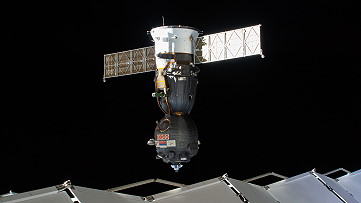 |
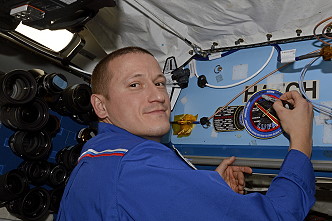 |
 |
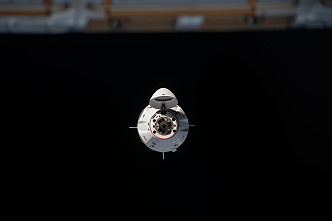 |
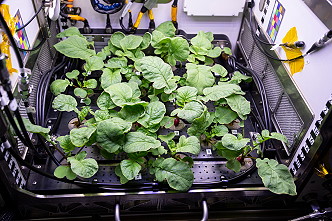 |
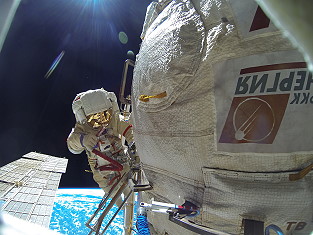 |
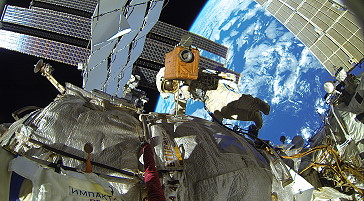 |
 |
 |
 |
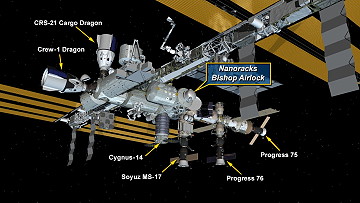 |
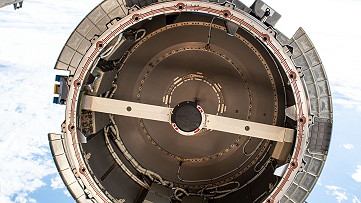 |
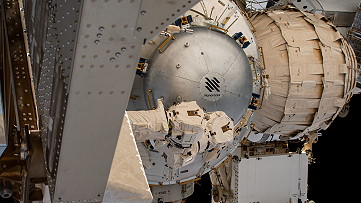 |
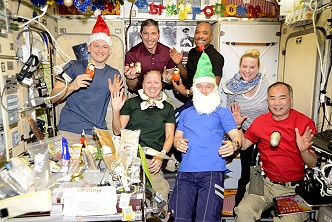 |
 |
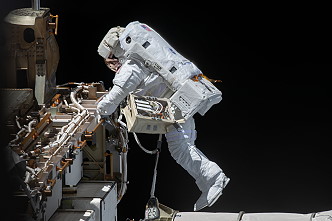 |
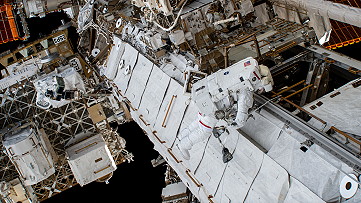 |
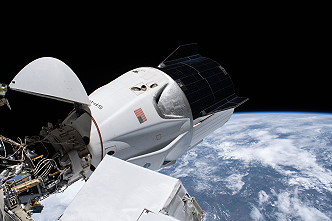 |
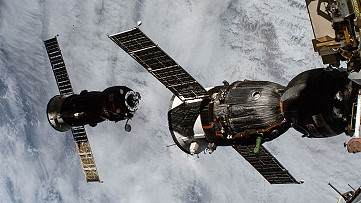 |
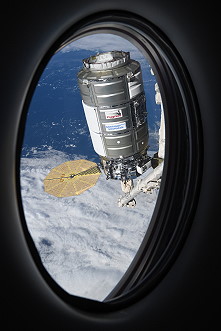 |
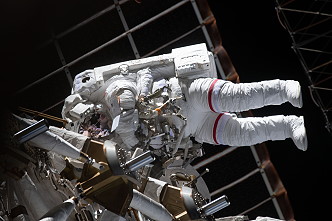 |
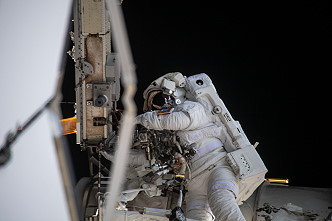 |
 |
 |
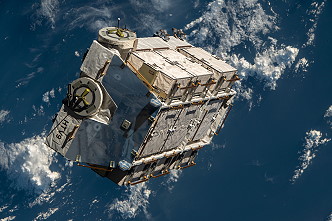 |
 |
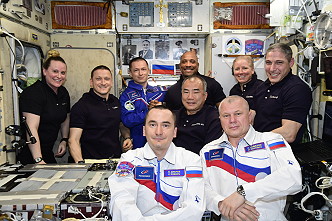 |
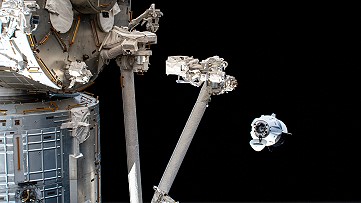 |
Earth observation photos |
|
more onboard photos |
|
more EVA photos |
|
| © |  |
Last update on May 22, 2024.  |
 |